

Kord-Valmark Petri Order Form. Microscopy of spores, hyphae, cystidia, trama, to identify fungi. The information below is a summarized extract from Pat O'Reilly's latest book, 'Fascinated by Fungi'.
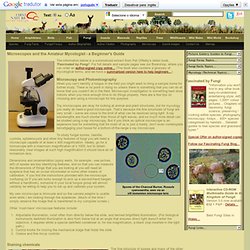
For full details and sample pages see our Bookshop, where you can order an author-signed copy online... (The book also contains a glossary of mycological terms, and we have a summarised version here to help beginners...) Microscopy and Photomicography When you can’t identify a fungus in the field you might want to bring a sample home for further study. There is no point in doing so unless there is something that you can do at home that you couldn’t do in the field. Toy microscopes are okay for looking at animal and plant structures, but for mycology you really do need a good microscope. Spores of the Charcoal Burner, Russula cyanoxantha, seen via an oill immersion microscope lens To study fungal spores, basidia, cystidia, sphaerocysts and other tiny features of fungi you will need a microscope capable of at least x 400 magnification.
Microscopic Spore Identification - Identifying Mushrooms - Wild Mushrooms. Dave, Of coarse we have the spores to study from our spore drop.
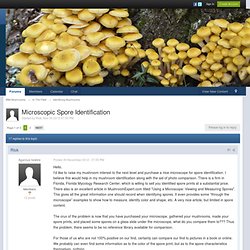
Then if one were to take a thin section of the pileus which included the lamellae (gills) perhaps we could also detect the basidium with spores attached. It certainly is an interesting area to develop. I was thinking that since you seem to have access to a biology department, why not take advantage of the equipment and knowledge on using the equipment. I'm sure the department must have a microtome and if so, you should try it out! One book that seems to be of great interest in this area Dave is titled How to Identify Mushrooms to Genus III:Microscopic Features by David Largent, David Johnson and Roy Watling.
News. Ed School Launches Self-Help Course on HarvardX The Graduate School of Education launched its first course through the online education platform HarvardX on Tuesday.

The new course—GSE1x: “Unlocking the Immunity to Change: A New Approach to Personal Improvement”—will focus on helping people achieve their personal goals through online videos, interactive elements, and forums.more Anant Agarwal on the future of EdX and a key new hire EdX has hired ex-Vistaprint executive Wendy Cebula as its president and COO. The nonprofit online learning platform has grown tremendously in two years and it's time to beef up the management team, according to Anant Agarwal, who has been serving as EdX's president and now will become its CEO. more Transitions How Do You Say 'MOOC' in Arabic?
"Massive Online Open Courses," abbreviated "MOOCs," are being hailed as a potentially revolutionary development in education. India hops onto MOOC bandwagon Who doesn’t want Ivy League education? Pages. Using a Microscope: Viewing and Measuring Spores. Using a Microscope: Viewing and Measuring Spores by Michael Kuo Observing spores, and measuring them, is the easiest of the various microscope routines involved in mycology.
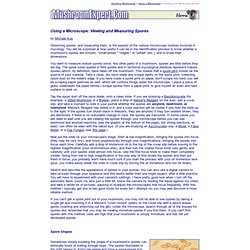
You will be surprised at how useful it can be in the identification process to know whether a mushroom's spores are smooth, "ornamented," "ridged," or "pitted" (etc.), and to know their dimensions. You want to measure mature spores since, like other parts of a mushroom, spores are little before they are big. The spore sizes quoted in field guides and in technical mycological literature represent mature spores--which, by definition, have fallen off the mushroom. Tap the spore dust off the razor blade, onto a clean slide. Introduction to Microscopy.
Introduction to Optical Microscopy,Digital Imaging, and Photomicrography This treatise on optical microscopy is divided into several sections that are available through the links displayed immediately to the left (in the darker navigational boxes) and below.
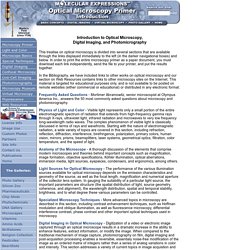
In order to print the entire microscopy primer as a paper document, you must download each link independently, send the file to your printer, and put the results together. In the Bibliography, we have included links to other works on optical microscopy and our section on Web Resources contains links to other microscopy sites on the Internet. This material is targeted for educational purposes only, and is not available to be posted on remote websites (either commercial or educational) or distributed in any electronic format.
Frequently Asked Questions - Mortimer Abramowitz, senior microscopist at Olympus America Inc., answers the 50 most commonly asked questions about microscopy and photomicrography. Questions or comments? Microscopic Images. Peering into the micro world. A team of University of Michigan researchers has recently created a set of electron microscope images of carbon nanotube structures depicting images of U.S.
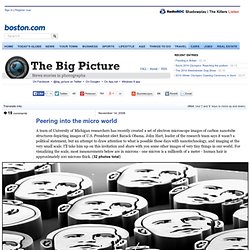
President-elect Barack Obama. John Hart, leader of the research team says it wasn't a political statement, but an attempt to draw attention to what is possible these days with nanotechnology, and imaging at the very small scale. I'll take him up on this invitation and share with you some other images of very tiny things in our world. For visualizing the scale, most measurements below are in microns - one micron is a millionth of a meter - human hair is approximately 100 microns thick. (32 photos total) Images of U.S.